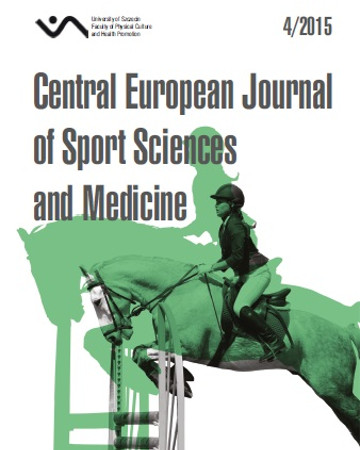
ISSN: 2300-9705
eISSN: 2353-2807
OAI
DOI: 10.18276/cej.2015.4-09




Lista wydań /
Vol. 12, No. 4/2015
Influence of Physical Activity on Reduction of Delayed Onset Muscle Soreness
| Autorzy: |
Jakub Grzegorz
Adamczyk
Department of Rehabilitation, Physiotherapy Division. Medical University of Warsaw, Poland ; Department of Theory of Sport. Józef Piłsudski University of Physical Education in Warsaw, Poland Dariusz Białoszewski Department of Rehabilitation, Physiotherapy Division. Medical University of Warsaw, Poland Dariusz Boguszewski Department of Rehabilitation, Physiotherapy Division. Medical University of Warsaw, Poland Beata Oko Department of Rehabilitation, Physiotherapy Division. Medical University of Warsaw, Poland Sylwia Szkoda Department of Rehabilitation, Physiotherapy Division. Medical University of Warsaw, Poland |
| Słowa kluczowe: | DOMS physical activity post-exercise recovery muscle damage IPAQ |
| Data publikacji całości: | 2015 |
| Liczba stron: | 8 (83-90) |
Abstrakt
The purpose of this study was to determine if physical activity of different intensity has an effect on reduction of delayed onset muscle soreness. Eighty women divided into two groups participated in the study. Subjects from Group 1 participated in the training of upper libs, whereas subjects from group 2 – in the training of lower limbs. Tests of power of upper limbs – the active overhang on the bar (Gr. 1) and power of lower limbs – the vertical jump test (Gr. 2), visual analog scale of pain (VAS) and the International Physical Activity Questionnaire (IPAQ) were used as investigative tools. The majority of studied women were characterized by the high level of physical activity. Physical activity level had strong positive correlation (r = 0.54; p < 0.001) with the reduction of pain. Taking into account the partition according to the kind of physical activity, there was observed some significant correlation between the diminution of delayed onset muscle soreness and the level of moderate activity and walking (relocating). Physical activity level positively correlated with the reduction of delayed onset muscle soreness. Moderate physical activity and walking proved to be the most beneficial from the reduction of delayed onset muscle soreness point of view.
Pobierz plik
Plik artykułu
Bibliografia
| 1. | Augustyn G., Wodnicka A., Szyguła Z. The influence of stretching on delayed onset of muscle soreness. Medicina Sportiva Practica. 2013; 14 (4): 97–99. |
| 2. | Bae S.H., Lee Y.S., Kim G.D., Kim K.Y. A quantitative evaluation of delayed onset muscular soreness according to application of Kinesio Taping. Advanced Science and Technology Letters. 2014; 47: 387–390. |
| 3. | Bednarek J., Kępińska M., Augustyn G., Szyguła Z. Fatigue and overtraining – an overview of the problem. Medicina Sportiva Practica. 2013; 14 (3): 83–88. |
| 4. | Best T.M., Hunter R., Wilcox A., Haq F. Effectiveness of sports massage for recovery of skeletal muscle from strenuous exercise. Clinical Journal of Sport Medicine. 2008; 18 (5): 446–460. |
| 5. | Bielski J. Life is movement. Guidebook for PE teachers. Promo-Lider, Warszawa 1996. |
| 6. | Biernat E., Stupnicki R., Lebiedziński B., Janczewska L. Assessment of physical activity by applying IPAQ questionnaire. Physical Education and Sport. 2008, 52: 46–52. |
| 7. | Boguszewski D., Poświata P., Oko B., Osipiuk S., Adamczyk J.G., Białoszewski D. Assessment of sports massage effectiveness in reduction of delayed onset muscle soreness of biceps brachii. Polish J Sport Med. 2013; 29 (4): 215–221. |
| 8. | Boguszewski D., Szkoda S., Adamczyk J.G., Białoszewski D. Sports massage therapy on the reduction of delayed onset muscle soreness of the quadriceps femoris. Human Movement. 2014, 15 (4): 234–237. |
| 9. | Cheung K., Hume P., Maxwell L. Delayed onset muscle soreness : treatment strategies and performance factors. Sports Med. 2003; 33 (2): 145–164. |
| 10. | Coudreuse J.M., Dupont P., Nicol C. Delayed post effort muscle soreness. Ann Readapt Med Phys. 2004 Aug; 47 (6): 290–298. |
| 11. | Czarkowska-Pączek B., Przybylski J. Zarys fizjologii wysiłku fizycznego. Elsevier Urban & Partner, Wrocław 2006. |
| 12. | Halson S.L. Nutrition, sleep and recovery. European Journal of Sport Science. 2008; 8 (2): 119–126. |
| 13. | Imtiyaz S., Veqar Z., Shareep M.Y. To compare the effect of vibration therapy and massage in prevention of delayed onset muscle soreness (DOMS). Journal of Clinical and Diagnostic Research. 2014; 8 (1): 133–136. |
| 14. | International Physical Activity Questionnaire, www.ipaq.ki.se/ipaq.htm (17.07.2012). |
| 15. | Kawczyński A., Mroczek D., Chmura P., Madeleine P., Chmura J. Influence of a professional football game on delayed onset muscle soreness development in dominant and non-dominant legs. Polish J Sport Med. 2013; 29 (1): 55–61. |
| 16. | Korzeniowska K., Szałek E. The pain. Farm Wspol. 2010; 3: 9–14. |
| 17. | Lee H., Petrofsky J.S., Laymon M., Yim J. A Greater Reduction of Anterior Cruciate Ligament Injury in Women Compared to Men as a Result Delayed Onset Muscle Soreness. The Thoku Journal of Experimental Medicine. 2013; 231: 111–115. |
| 18. | Punduk Z., Oral O., Aydinoglu R., Ozkayin N. Exercise induced muscle damage may be improved by a single dose of intra-muscular platlet rich plasma: A Pilot Study. Centr Eur J Sport Sci Med. 2014; 8 (4): 19–26. |
| 19. | Willems M.E.T., Hale T., Wilkinson C.S. Effects of manual massage on muscle specific soreness and single leg jump performance after downhill treadmill walking. Medicina Sportiva. 2009; 13 (2): 61–66. |
| 20. | Wilmore J.H., Costill D.L. Physiology of sport and exercise. Human Kinetics, Champaign 2004. |
| 21. | Zainuddin Z., Newton M., Sacco P., Nosaka K. Effects of massage on delayed-onset muscle soreness, swelling, and recovery of muscle function. J Athl Train. 2005 Jul-Sep; 40 (3): 174–180. |
| 22. | Zainuddin Z., Sacco P., Newton M., Nosaka K. Light concentric exercise has a temporarily analgesic effect on delayed-onset muscle soreness, but no effect on recovery from eccentric exercise. Appl Physiol Nutr Metab. 2006 Apr; 31 (2): 126–134. |